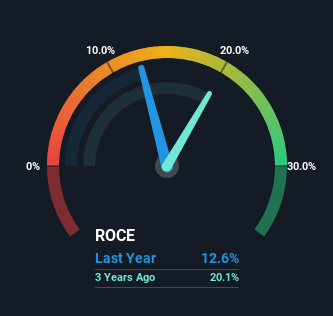- South Korea
- /
- Machinery
- /
- KOSE:A210540
Investors Could Be Concerned With DY Power's (KRX:210540) Returns On Capital

If we want to find a stock that could multiply over the long term, what are the underlying trends we should look for? Firstly, we'd want to identify a growing return on capital employed (ROCE) and then alongside that, an ever-increasing base of capital employed. Ultimately, this demonstrates that it's a business that is reinvesting profits at increasing rates of return. In light of that, when we looked at DY Power (KRX:210540) and its ROCE trend, we weren't exactly thrilled.
What Is Return On Capital Employed (ROCE)?
For those who don't know, ROCE is a measure of a company's yearly pre-tax profit (its return), relative to the capital employed in the business. The formula for this calculation on DY Power is:
Return on Capital Employed = Earnings Before Interest and Tax (EBIT) ÷ (Total Assets - Current Liabilities)
0.13 = ₩34b ÷ (₩347b - ₩74b) (Based on the trailing twelve months to March 2024).
Therefore, DY Power has an ROCE of 13%. On its own, that's a standard return, however it's much better than the 6.3% generated by the Machinery industry.
View our latest analysis for DY Power

Historical performance is a great place to start when researching a stock so above you can see the gauge for DY Power's ROCE against it's prior returns. If you'd like to look at how DY Power has performed in the past in other metrics, you can view this free graph of DY Power's past earnings, revenue and cash flow.
How Are Returns Trending?
When we looked at the ROCE trend at DY Power, we didn't gain much confidence. Over the last five years, returns on capital have decreased to 13% from 21% five years ago. On the other hand, the company has been employing more capital without a corresponding improvement in sales in the last year, which could suggest these investments are longer term plays. It's worth keeping an eye on the company's earnings from here on to see if these investments do end up contributing to the bottom line.
On a side note, DY Power has done well to pay down its current liabilities to 21% of total assets. That could partly explain why the ROCE has dropped. What's more, this can reduce some aspects of risk to the business because now the company's suppliers or short-term creditors are funding less of its operations. Some would claim this reduces the business' efficiency at generating ROCE since it is now funding more of the operations with its own money.
In Conclusion...
To conclude, we've found that DY Power is reinvesting in the business, but returns have been falling. And with the stock having returned a mere 19% in the last five years to shareholders, you could argue that they're aware of these lackluster trends. Therefore, if you're looking for a multi-bagger, we'd propose looking at other options.
Like most companies, DY Power does come with some risks, and we've found 1 warning sign that you should be aware of.
While DY Power isn't earning the highest return, check out this free list of companies that are earning high returns on equity with solid balance sheets.
New: Manage All Your Stock Portfolios in One Place
We've created the ultimate portfolio companion for stock investors, and it's free.
• Connect an unlimited number of Portfolios and see your total in one currency
• Be alerted to new Warning Signs or Risks via email or mobile
• Track the Fair Value of your stocks
Have feedback on this article? Concerned about the content? Get in touch with us directly. Alternatively, email editorial-team (at) simplywallst.com.
This article by Simply Wall St is general in nature. We provide commentary based on historical data and analyst forecasts only using an unbiased methodology and our articles are not intended to be financial advice. It does not constitute a recommendation to buy or sell any stock, and does not take account of your objectives, or your financial situation. We aim to bring you long-term focused analysis driven by fundamental data. Note that our analysis may not factor in the latest price-sensitive company announcements or qualitative material. Simply Wall St has no position in any stocks mentioned.
Have feedback on this article? Concerned about the content? Get in touch with us directly. Alternatively, email editorial-team@simplywallst.com
About KOSE:A210540
DY Power
Engages in production and sales of hydraulic cylinders for construction equipment in Korea.
Flawless balance sheet and good value.
Market Insights
Community Narratives




